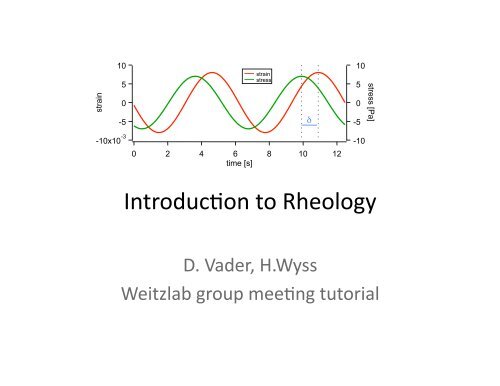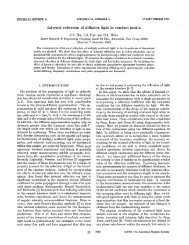Introduction to Rheology
Introduction to Rheology
Introduction to Rheology
Create successful ePaper yourself
Turn your PDF publications into a flip-book with our unique Google optimized e-Paper software.
strain<br />
10<br />
5<br />
0<br />
-5<br />
-10x10 -3<br />
0<br />
2<br />
4<br />
6<br />
time [s]<br />
strain<br />
stress<br />
Introduc)on <strong>to</strong> <strong>Rheology</strong> <br />
D. Vader, H.Wyss <br />
Weitzlab group mee)ng tu<strong>to</strong>rial <br />
8<br />
10<br />
δ<br />
12<br />
10<br />
5<br />
0<br />
-5<br />
-10<br />
stress [Pa]
What is rheology? <br />
• <strong>Rheology</strong> is the study of the flow of maBer: mainly <br />
liquids but also soE solids or solids under condi)ons in <br />
which they flow rather than deform elas)cally. It <br />
applies <strong>to</strong> substances which have a complex structure, <br />
including muds, sludges, suspensions, polymers, many <br />
foods, bodily fluids, and other biological materials. <br />
Cheese<br />
Foams<br />
Emulsions<br />
Biopolymers
What is rheology? <br />
• The term rheology was coined in 1920s, and <br />
was inspired by a Greek quota)on, "panta rei", <br />
"everything flows". <br />
• In prac)ce, rheology is principally concerned <br />
with extending the "classical" disciplines of <br />
elas)city and (New<strong>to</strong>nian) fluid mechanics <strong>to</strong> <br />
materials whose mechanical behavior cannot <br />
be described with the classical theories.
Basic concepts <br />
h<br />
L<br />
area A<br />
area A<br />
F<br />
L + ΔL<br />
F<br />
F<br />
Δx<br />
F
Simple mechanical elements <br />
Elastic solid: force (stress) proportional <strong>to</strong> strain<br />
Viscous fluid: force (stress) proportional <strong>to</strong> strain rate<br />
Viscoelastic material: time scales are important<br />
Fast deformation: solid-like<br />
Slow deformation: fluid-like
Response <strong>to</strong> deforma)on <br />
Step strain<br />
stress<br />
stress<br />
stress<br />
time<br />
time<br />
time<br />
time
Oscilla<strong>to</strong>ry rheology <br />
strain<br />
Elastic solid:<br />
Viscous fluid:<br />
10<br />
-5<br />
-10x10 -3<br />
Viscoelastic material, use:<br />
5<br />
0<br />
0<br />
2<br />
4<br />
6<br />
time [s]<br />
strain<br />
stress<br />
8<br />
10<br />
12<br />
-10<br />
Stress and strain are in phase<br />
Stress and strain are out of phase<br />
δ<br />
10<br />
5<br />
0<br />
-5<br />
stress [Pa]
Lissajou plots <br />
strain<br />
strain rate [1/s]<br />
10<br />
5<br />
0<br />
-5<br />
-10x10 -3<br />
10<br />
5<br />
0<br />
-5<br />
-10x10 -3<br />
0<br />
0<br />
2<br />
2<br />
4<br />
strain rate<br />
stress<br />
4<br />
6<br />
time [s]<br />
6<br />
time [s]<br />
strain<br />
stress<br />
8<br />
8<br />
10<br />
10<br />
δ<br />
12<br />
12<br />
10<br />
5<br />
0<br />
-5<br />
-10<br />
10<br />
5<br />
0<br />
-5<br />
-10<br />
stress [Pa]<br />
stress [Pa]<br />
stress [Pa]<br />
stress [Pa]<br />
10<br />
5<br />
0<br />
-5<br />
-10<br />
Lissajou <br />
G'<br />
-10x10 -3 -5 0 5 10<br />
strain<br />
10<br />
5<br />
0<br />
-5<br />
-10<br />
G''/ ω<br />
-10x10 -3 -5 0 5 10<br />
strain rate [1/s]
Strain‐control vs stress‐control <br />
Strain-controlled Stress-controlled<br />
ARES Bohlin, AR-G2, An<strong>to</strong>n Paar
Strain‐control vs stress‐control <br />
• Strain‐controlled state typically considered <br />
be2er defined <br />
• Stress‐controlled rheometers have beBer <br />
<strong>to</strong>rque sensi)vity <br />
• Strain‐controlled rheometers can probe higher <br />
frequencies <br />
• BUT… nowadays, feedback loops are fast <br />
enough that most rheometers can operate OK <br />
in both modes
Rheometer geometries <br />
� Cone-plate<br />
• uniform strain / strain-rate<br />
• fixed gap height<br />
� Plate-plate<br />
• non-uniform strain<br />
• adjustable gap height<br />
• good for testing boundary effects like slip<br />
� Couette cell<br />
• good sensitivity for low-viscosity fluids
Linear viscoelas)city <br />
Acquire data at constant frequency, increasing stress/strain<br />
strain amplitude γ 0<br />
s<strong>to</strong>rage modulus G’<br />
loss modulus G”
Typical pro<strong>to</strong>col <br />
• Limits of linear viscoelas)c regime in desired <br />
frequency range using amplitude sweeps <br />
=> yield stress/strain, cri)cal stress/strain <br />
• Test for )me stability, i.e )me sweep at constain <br />
amplitude and frequency <br />
• Frequency sweep at various strain/stress <br />
amplitudes within linear regime <br />
• Study non‐linear regime
Nonlinear rheology (of biopolymers) <br />
• “Unlike simple polymer gels, many biological materials—<br />
including blood vessels, mesentery
Oscilla<strong>to</strong>ry strain sweeps (collagen gels)
Lissajou plots from the G2 Raw data <strong>to</strong>ol <br />
Lissajou plot, 1% strain
Nonlinear Lissajou plot<br />
stress [Pa] <br />
4 <br />
2 <br />
0 <br />
-2 <br />
-4 <br />
-40x10 -3 <br />
-20 0 20 40 <br />
strain
Nonlinear Lissajou plot<br />
stress [Pa] <br />
4 <br />
2 <br />
0 <br />
-2 <br />
-4 <br />
-40x10 -3 <br />
RAW DATA <br />
σ ' (elastic stress) <br />
fit <strong>to</strong> σ ' <br />
-20 0 20 40 <br />
strain
2.4mg/mL cone‐plate
2.4mg/mL cone‐plate
MIT LAOS MATLAB package
Creep‐ringing
Creep‐ringing <br />
• Norman & Ryan’s work here (fibrin, jamming) <br />
• Good tu<strong>to</strong>rial by Ewoldt & McKinley (MIT)
Creep‐ringing results <br />
I: bulk proper)es
More nonlinear rheology <br />
• Stress/strain ramps with constant rate <br />
• Pre‐stress measurements, i.e. small stress <br />
oscilla)ons around a constant (pre‐)stress <br />
• Pre‐strain measurements <br />
• Transient responses in LAOS (talk <strong>to</strong> Stefan) <br />
• Fourier domain analysis <br />
• SRFS (talk <strong>to</strong> Hans) Linear behavior
Origin of nonlinear behavior <br />
• Distribu)on of length‐scales / inhomogenei)es <br />
• Rearrangement of par)cles / filaments <br />
• Non‐affine mo)on <br />
• How do we find out? <br />
Observation at the microscopic scale:<br />
• Microrheology<br />
• Microscopy
Microrheology basics <br />
• General idea: look at the thermally‐driven <br />
mo)on of micron‐sized par)cles embedded in a <br />
material <br />
• Mean‐square displacement of par)cles as a <br />
func)on of )me provides microscopic <br />
informa)on on local elas)c and viscous material <br />
proper)es as a func)on of frequency <br />
• Mason and Weitz, PRL, 1995
Short and long )mescales <br />
Short time scales:<br />
diffusive<br />
r: position vec<strong>to</strong>r<br />
D: diffusion constant<br />
τ: lag time<br />
kT: thermal energy<br />
a: particle size<br />
η: viscosity<br />
What about intermediate times?<br />
Long time scales:<br />
spring-like<br />
K: effective springconstant,<br />
linked <strong>to</strong><br />
elastic properties
Generalized S<strong>to</strong>kes‐Einstein <br />
Take Laplace transform of η(τ) numerically, <strong>to</strong> get η(s) – with s=iω.<br />
From earlier, we know:<br />
We can then get the generalized complex modulus, by analytically extending:<br />
i.e.
2‐point vs 1‐point microrheology <br />
2-point microrheology calculates a<br />
mean-square displacement from<br />
the correlated pair-wise motion of<br />
particles, rather than the singleparticle<br />
MSD.<br />
Black: bulk rheology<br />
Red: 2-point microrheology<br />
Blue: 1-point microrheology<br />
Open symbols: G”
Other considera)ons <br />
• Non‐linear regime non‐trivial, but more <br />
interes)ng. <br />
• Surface effects can be important. <br />
• Imaging <strong>to</strong> figure out mechanisms. <br />
• Richness of effects, mechanisms, )me‐, length‐ <br />
and energy‐ scales present in soE maBer / <br />
complex fluids. <br />
• More <strong>to</strong> explore on Weitzlab webpage. <br />
• More at ComplexFluids mee)ngs.





